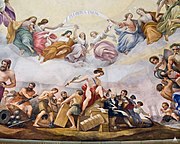The Apotheosis of Washington

The Apotheosis of Washington is the
The fresco is suspended 180 feet (55 m) above the rotunda floor and covers an area of 4,664 square feet (433.3 m2). The figures painted are up to 15 feet (4.6 m) tall and are visible from the floor below. The dome was completed in 1863, and Brumidi painted it over the course of eleven months at the end of the American Civil War. He was paid $40,000 ($796,174 in today's funds[1]) for the fresco.
Brumidi had worked for three years in the Vatican under Pope Gregory XVI, and served several aristocrats as an artist for palaces and villas, including the prince Torlonia. He immigrated to the United States in 1852, and spent much of the last 25 years of his life working in the Capitol. In addition to The Apotheosis of Washington, Brumidi designed the Brumidi Corridors, ornately decorated corridors on the first floor of the Senate wing of the Capitol.
Symbolism
The Apotheosis of Washington depicts George Washington sitting among the heavens in an exalted manner, or in literary terms, ascending and becoming a god (apotheosis). Washington, the first U.S. president and commander-in-chief of the Continental Army during the American Revolutionary War, is allegorically represented, surrounded by figures from classical mythology.
George Washington is draped in purple, worn by generals of the ancient Roman Republic during their triumphs, with a rainbow arch at his feet, flanked by the goddess Victoria, who is draped in green, using a horn, to his left and the goddess of Liberty to his right. Liberty wears a red liberty cap, symbolizing emancipation, from a Roman tradition where slaves being manumitted would be given a felt cap (Latin pileus). She holds a fasces in her right hand and an open book in the other, to which George Washington gestures with his right hand.
Forming a circle between Liberty and Victory are 13 maidens, each with a star above her head representing the original
Surrounding George Washington, the two goddesses and the 13 maidens are six scenes lining the perimeter, each representing a national concept allegorically: from directly below George Washington in the center and moving clockwise, "War", "Science", "Marine", "Commerce", "Mechanics" and "Agriculture". The perimeter scenes are not fully visible from the floor of the United States Capitol.
| Scene | Description |
|---|---|

|
War Tyranny and Kingly Power. To Freedom's left assisting her is a fierce bald eagle (the national bird of the United States) carrying arrows and a thunderbolt (reminiscent of the arrows carried by the eagle in the Great Seal of the United States ).
|

|
Science Samuel F. B. Morse, and Robert Fulton watch. In the left part of the scene a teacher demonstrates the use of dividers.
|

|
Marine This scene shows smokestacks .
|

|
Commerce lead into "Marine". |

|
Mechanics Vulcan, the Roman god of fire and the forge, is depicted standing at an anvil with his foot on a cannon next to a pile of cannonballs. A steam engine is in the background. The man at the forge is thought to represent Charles Thomas, the supervisor of ironwork during the construction of the Capitol dome. |

|
Agriculture Ceres, the Roman goddess of agriculture, is shown with a wreath of wheat and a cornucopia, symbol of plenty, while sitting on a McCormick mechanical reaper. The personification of Young America in a liberty cap holds the reins of the horses, while the goddess Flora gathers flowers in the foreground.
|
See also
- American civil religion
- Apotheosis
- Panthéon, Paris– building with a dome fresco titled The Apotheosis of Saint Genevieve
- George Washington (Greenough)
References
- ^ 1634–1699: McCusker, J. J. (1997). How Much Is That in Real Money? A Historical Price Index for Use as a Deflator of Money Values in the Economy of the United States: Addenda et Corrigenda (PDF). American Antiquarian Society. 1700–1799: McCusker, J. J. (1992). How Much Is That in Real Money? A Historical Price Index for Use as a Deflator of Money Values in the Economy of the United States (PDF). American Antiquarian Society. 1800–present: Federal Reserve Bank of Minneapolis. "Consumer Price Index (estimate) 1800–". Retrieved February 29, 2024.
- ^ buchanan-solutions.com. "Valentia Island, Ireland". The Telegraph Field. Archived from the original on 2013-06-21. Retrieved 2013-07-02.
External links
- The Apotheosis of Washington, Architect of the Capitol.
- The Apotheosis of George Washington : Brumidi's fresco & Beyond, The University of Virginia.
- The Telegraph Field : Valentia Island, Ireland.
- Figure 49. Study for the Apotheosis of George Washington, c. 1863 (photo), Irma B. Jaffe (1992). The Italian presence in American art, 1860–1920. Fordham Univ Press. pp. 85. ISBN 978-0-8232-1342-9.
- apotheosisofwashington.com, dedicated website with interactive panorama view
- Presidents Day and the Apotheosis of Washington, Online Library of Liberty
